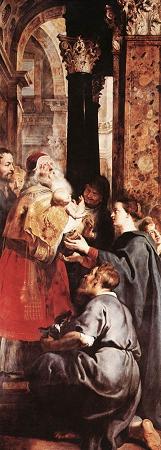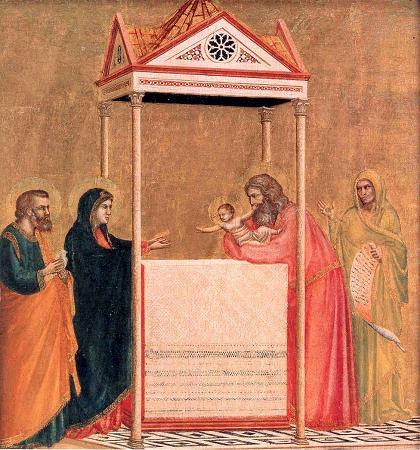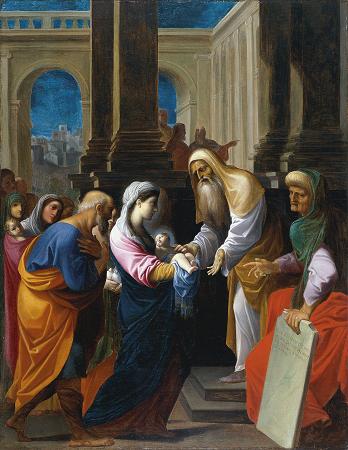Presentation in Temple. The Presentation of Jesus at the Temple is an early episode in the life of Jesus, describing his presentation at the Temple in Jerusalem in order to officially induct him into Judaism, that is celebrated by many Christian Churches on the holiday of Candlemas. It is described in the chapter 2 of the Gospel of Luke in the New Testament of the Christian Bible. Within the account, Luke's narration of the Presentation in the Temple combines the purification rite with the Jewish ceremony of the redemption of the firstborn. In the Eastern Orthodox Church, the Presentation of Jesus at the temple is celebrated as one of the twelve Great Feasts, and is sometimes called Hypapante. In Western Christianity, the additional name for the Service the day, Candlemas, is added. This Feast-day is also known as the Feast of the Purification of the Virgin or the Meeting of the Lord.In some liturgical churches, Vespers on the Feast of the Presentation marks the end of the Epiphany season. In the Church of England, the Mother Church of the Anglican Communion, the Presentation of Christ in the Temple is a Principal Feast celebrated either on 2 February or on the Sunday between 28 January and 3 February. In the Catholic Church, especially since the time of Pope Gelasius I who in the fifth century contributed to its expansion, the Presentation is celebrated on 2 February and is the fourth Joyful Mystery of the Rosary. In the Latin Rite of the Catholic Church, the Anglican Communion and the Lutheran Church, the episode was also reflected in the once-prevalent custom of churching new mothers forty days after the birth of a child. The event is described in the Gospel of Luke. According to the gospel, Mary and Joseph took the Infant Jesus to the Temple in Jerusalem forty days after his birth to complete Mary's ritual purification after childbirth, and to perform the redemption of the firstborn son, in obedience to the Torah. Luke explicitly says that Joseph and Mary take the option provided for poor people, sacrificing a pair of turtledoves, or two young pigeons. Leviticus 12:1-4 indicates that this event should take place forty days after birth for a male child, hence the Presentation is celebrated forty days after Christmas. Upon bringing Jesus into the temple, they encountered Simeon. The Gospel records that Simeon had been promised that he should not see death before he had seen the Lord's Christ. Simeon then uttered the prayer that would become known as the Nunc Dimittis, or Canticle of Simeon, which prophesied the redemption of the world by Jesus: Lord, now let your servant depart in peace,according to your word; for my eyes have seen your salvation which you have prepared in the presence of all peoples, a light for revelation to the Gentiles, and for glory to your people Israel. Simeon then prophesied to Mary: Behold, this child is set for the fall and rising of many in Israel, and for a sign that is spoken against, that thoughts out of many hearts may be revealed. The elderly prophetess Anna was also in the Temple, and offered prayers and praise to God for Jesus, and spoke to everyone there of His importance to redemption in Jerusalem. The event forms a usual component of extensive cycles of the Life of Christ and also of the Life of the Virgin. Often either the Presentation of Jesus or the visually similar Circumcision of Jesus was shown, but by the late Middle Ages the two were sometimes combined. Early images concentrated on the moment of meeting with Simeon, typically shown at the entrance to the Temple, and this is continued in Byzantine art and Eastern Orthodox icons to the present day. In the West, beginning in the 8th or 9th century, a different depiction at an altar emerged, where Simeon eventually by the Late Middle Ages came to be shown wearing the elaborate vestments attributed to the Jewish High Priest, and conducting a liturgical ceremony surrounded by the family and Anna. In the West, Simeon is more often already holding the infant, or the moment of handover is shown; in Eastern images the Virgin is more likely still to hold Jesus. Many motets and anthems have been composed to celebrate this feast and are performed as part of the liturgy, among them an anthem by 16th century German composer Johannes Eccard, Maria wallt zum Heiligtum, often translated in English as When Mary to the Temple went. The Lutheran church of the Baroque observed the feast as Mariae Reinigung.
more...














